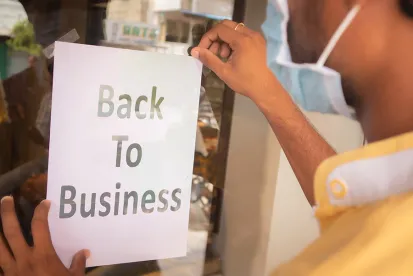Almost a year into the business disruptions caused by the pandemic, businesses continue to find ways to adapt and to comply with new pricing restrictions. Some of these changes relate to additional costs that businesses may need to pass along to consumers — at least in part. Given what we have seen in recent months, it is worth revisiting how businesses can implement these surcharges with an eye towards compliance with local price gouging laws.
Whether a surcharge is permissible generally depends on a number of factors, including: the industry, how and when the surcharge was disclosed to consumers, and the amount of the surcharge. Legal surcharges are not uncommon, though, as a spokesperson for the Michigan Attorney General’s Office recently noted, “determining if a COVID-19 surcharge is legal or illegal is ‘no quick and easy answer.’”
Industry: It is hard to imagine an industry that has not been impacted by the challenges of the past year in one way or another. Different industries may face different levels of scrutiny, however, and may bear different kinds of additional costs. We have discussed a number of industries that have been experimenting with surcharges to offset their increased costs, and they range from health care providers to hair salons to restaurants.
Disclosure: Disclosure is often a key consideration when surcharges are being challenged or investigated. Concerns are likely to be raised—and complaints and investigations are more likely to follow—when these fees are perceived as “hidden,” as reflected in a recent Washington Post article. In some instances, disclosing a surcharge in advance is an explicit requirement, such as for the “COVID-19 Recovery Charges” restaurants are permitted to pass on to customers in New York City.
Amount: It remains true that, to the extent surcharges are put in place to reflect cost increases, they may fall within allowable price gouging exceptions. An important consideration is whether the contemplated surcharges are related to increase costs because of the pandemic. This could look like increased transportation costs, procurement costs, or labor costs due to new or increased expenses to cover, such as for testing, disinfection, personal protective equipment, or infection control.
Businesses that are otherwise subject to pricing restrictions under current emergency orders and the attendant regulations may be able to justify such surcharges. But that may not always be the case. Even if they bear new costs, businesses may be constrained by the language of the particular price gouging laws that apply to them. Some businesses may find themselves subject to local price gouging laws, which, e.g., bans “exorbitant” or “unconscionable” prices increases,” caps them at a specific percentage, or simply bar increases outright. The Massachusetts Attorney General, for example, issued an advisory in December with information for consumer and dental practices, noting that contracts between a consumer’s insurer and their provider may prohibit any additional fees.
The takeaway is that business often are able to legitimately recover cost increases and pass them on as surcharges or price increase, but must remain mindful of the limitations that remain in place, and maintain strong compliance measures when implementing surcharges.





 />i
/>i

